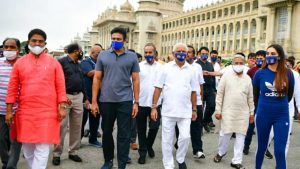
Karnataka government observed the “Mask Day” on 18 June 2020. The Mask Day was observed to aware the people about the use of masks, sanitisers, washing hands with soap in order to control the spread of COVID-19 in the state. It also urged the people to maintain the social distancing norms.
Click Here To Get Test Series For SBI PO 2020
To observe “Mask Day”, the Karnataka government organised a march which featured the participation of public representatives, dignitaries and medical staff. Through the march, the participants spread awareness among the people about the national directives issued to contain the COVID-19.
Important takeaways for all competitive exams:
- Chief Minister of Karnataka: B. S. Yediyurappa; Governor: Vajubhai Vala.



 Which Indian City is Known as the Footwe...
Which Indian City is Known as the Footwe...
 Which Desert is known as the Cold Desert...
Which Desert is known as the Cold Desert...
 Top-10 News Media Companies in the World...
Top-10 News Media Companies in the World...







